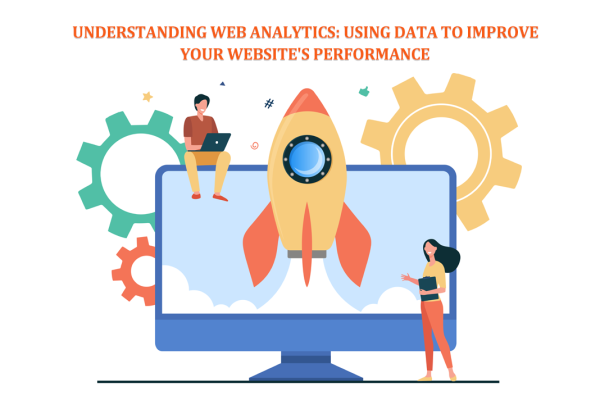Understanding Web Analytics: Using Data to Improve Your Website's Performance

Why are web analytics important?
Web analytics is essential for any business or organization with a website.
It involves collecting and analyzing data on your website's performance to gain insights into user behavior, identify areas for improvement, and make data-driven decisions to optimize your website's performance.
With the vast amount of data available, web analytics can seem overwhelming, but it can be a powerful tool for driving success with the right tools and approach.
In this article, we'll explore the key concepts and best practices of web analytics to help you improve your website's performance and achieve your business objectives.
Importance of Website Performance
A website is the digital face of your business or organization, and in today's digital age, it is often the first point of contact with potential customers or clients. As such, it's important that your website not only looks good but also performs well.
Website performance refers to how well your website meets the needs of its users, and it is critical to the success of your business or organization. This article will discuss why website performance is important and how it can impact your bottom line.
User Experience
One of the most important reasons why website performance is important is because it directly impacts user experience. A website that is slow to load, difficult to navigate, or confusing to use can turn off potential customers or clients and lead to a high bounce rate.
On the other hand, a fast, easy-to-navigate, and user-friendly website with latest features like WooCommerce request a quote can lead to a positive user experience and encourage visitors to stay on your website longer and engage more with your content.
Search Engine Optimization
Website performance is also key to search engine optimization (SEO). Search engines like Google use a variety of factors to determine how to rank websites in search results, and website performance is one of them.
Page speed, mobile responsiveness, and user engagement contribute to a website's SEO performance. A website that performs well in these areas is more likely to rank higher in search results, which can drive more traffic to your website and increase your visibility online.
Conversions
The aim of your site is to adapt visitors into potential customers. Performance of your website is directly proportional to conversion rate.
A slow or poorly performing website can lead to a high bounce rate and fewer conversions, while a fast and user-friendly website can lead to a higher conversion rate.
Optimizing your website's performance can create a better user experience and improve your chances of converting visitors into customers or clients.
Reputation
Your website is often the first point of contact with potential customers or clients, and it must reflect well on your business or organization.
A poorly performing website can give the impression that your business could be more professional and trustworthy. In contrast, a fast and user-friendly website can enhance your reputation and build trust with your audience.
Cost Savings
Optimizing your website's performance can lead to cost savings in the long run. A slow or poorly performing website can increase bounce rates and fewer conversions, costing you money.
Optimizing your website's performance can improve your conversion rate and reduce your bounce rate, leading to increased revenue and cost savings over time.
How to Use Data to Improve Website's Performance
Web analytics collects, analyzes, and interprets data from your website to understand its performance and user behavior.
Using web analytics, you can gain insights into how visitors interact with your website, identify areas for improvement, and make data-driven decisions to optimize your website's performance.
Below we'll discuss some key concepts and best practices to help you improve your website's performance using web analytics.
-
Setting up Web Analytics
The first step in using web analytics is to set up a tracking system to collect data from your website. The most common tool for this is Google Analytics, which is free and easy to set up.
Once you have set up your tracking code on your website, you can start collecting data on your visitor's behavior, including the pages they visit, the time they spend on your site, and the actions they take.
-
Defining Goals and Metrics
Before analyzing your data, you must define your website's goals and the key metrics you will use to measure success. Your goals should be achievable and aligned with your mission statement.
For example, if you're an e-commerce website, your goals include increasing sales or improving your conversion rate.
The metrics you choose will depend on your goals and the insights you want to gain from your data. Some common metrics to track include pageviews, bounce rate, time on site, conversion rate, and average order value.
By monitoring these metrics over time, you can identify trends and areas for improvement.
-
Analyzing Data
Once you have collected data on your website's performance, it's time to analyze it. There are many ways to approach data analysis, but some key best practices include the following:
-
Segmentation
Analyzing data by segments can help you better understand how different groups of users interact with your website—for example, research data by demographics, device type, or referral source.
-
Comparison
Comparing data over time or between different segments can help you identify trends and areas for improvement. For example, compare data from different periods or traffic sources.
-
Visualization
Visualizing data in charts, graphs, and tables can help you quickly identify patterns and trends. Many web analytics tools offer built-in visualization options, or you can use external tools like Excel or Google Sheets.
-
Making Data-Driven Decisions
Web analytics aims to use data to make informed decisions about improving your website's performance. By analyzing your data and identifying areas for improvement, you can make changes to your website and measure the impact of those changes over time.
Some examples of data-driven decisions you might make include:
- Improving website content: If visitors spend a lot of time on a particular page, you can improve the content to make it more engaging.
- Optimizing navigation: If visitors frequently leave your website after visiting a certain page, you can optimize your navigation to make finding what they're looking for easier.
- A/B testing: A/B testing involves making two versions of a webpage and testing them against each other to see which performs better. By using data to inform your A/B testing, you can make more informed decisions about which changes to make to your website.
- Continuous Improvement
Finally, it's important to remember that web analytics is ongoing. Your website is constantly evolving, and so are your visitors' behaviors.
By continuously monitoring your data and making data-driven decisions, you can ensure that your website is always improving and meeting the needs of your visitors.
Takeaway
website performance is crucial for the success of any business or organization with a website. It directly impacts user experience, search engine optimization, conversions, reputation, and cost savings.
Collecting and analyzing data through web analytics allows you to gain insights into your website's performance and make data-driven decisions to optimize it.
Optimizing website performance can lead to a better user experience, improved search engine rankings, increased conversion rates, enhanced reputation, and cost savings.
By prioritizing website performance, you can take your website to the next level and drive success for your business or organization.
Would you like to find out more?
If you would like to find out how we can help you, please give us a call on +44 1243 776399. 24 hours a day, 7 days a week!
Run Your Own Website is created by Access by Design
Award-winning Web Design, Chichester
